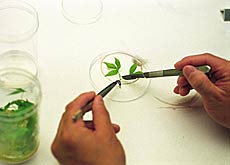
Software solution speeds gene decoding

A new process for rapidly identifying how plant and animal genes respond to different environmental conditions has been designed by scientists at Fribourg University.
The computer programme, which was three years in the making, will enable doctors and biologists to have a better understanding of how organisms react to extremes of temperature and disease.
Finding out which genes react to specific conditions such as heat, cold and disease has in the past been a time-consuming business. A plant may have 22,000 genes, and scientists could spend several years trying to analyse just a handful of them.
Thanks to the advances of DNA microarray technology – which allows the study of thousands of genes at any one time – scientists can now examine how these basic biological units of heredity behave in just a matter of weeks.
But this technique produces a mass of complex data for researchers to sift through, which is where Fribourg University’s FiRe (Find Regulons) software comes in.
Using this tool, information gathered during the microarray process can be compared, analysed and visualised in a short space of time. FiRe can also assemble data from different experiments.
According to Jean-Pierre Métraux, head of plant biology at Fribourg University, the development represents a “huge leap forward”.
“When you make microarrays you usually have huge sets of data. FiRe will sort these numbers in a very fast way, so that you can make sense of your experiment,” he told swissinfo.
Active genes
Métraux said the new application would allow people to quickly see which genes were actively used and which ones were repressed in any given situation.
He added that the programme could prove useful for medical diagnostics and those working in the plant, microbiology and animal world.
“For example, it will allow scientists to have a better understanding of how plants react to stress, cold, or disease. Or how they react during development and what happens during flowering,” said Métraux.
Fribourg University says FiRe will do away with “cumbersome hand-sorting” of data, which carries the associated risk of mistakes.
Scientific interest
The programme has already attracted a fair amount of interest since news of its development was published in the June issue of the scientific review, Trends in Plant Science.
Since the beginning of July around 400 people have downloaded the programme, which will function alongside Microsoft’s Excel spreadsheet software.
“In the past I would ask a student to find out which plant genes are induced in a given treatment. That student would complete a PhD and come out with maybe four genes,” said Métraux.
“Now I can do the same experiment with microarray technology and get 3,000 genes. The basic experimental labour time is maybe two to three weeks, and the software we built means you can now interpret these results quicker.”
swissinfo, Adam Beaumont
The FiRe software programme is the result of a three-year collaboration between the mathematics and biology departments at Fribourg University.
It is adapted to work on all PCs fitted with Microsoft Excel.
Around 400 people have downloaded the programme since it was launched early this month.

In compliance with the JTI standards
More: SWI swissinfo.ch certified by the Journalism Trust Initiative
















![The four-metre-long painting "Sonntag der Bergbauern" [Sunday of the Mountain Farmers, 1923-24/26] had to be removed by a crane from the German Chancellery in Berlin for the exhibition in Bern.](https://www.swissinfo.ch/content/wp-content/uploads/sites/13/2025/12/01_Pressebild_KirchnerxKirchner.jpg?ver=cb688ed5)














You can find an overview of ongoing debates with our journalists here . Please join us!
If you want to start a conversation about a topic raised in this article or want to report factual errors, email us at english@swissinfo.ch.